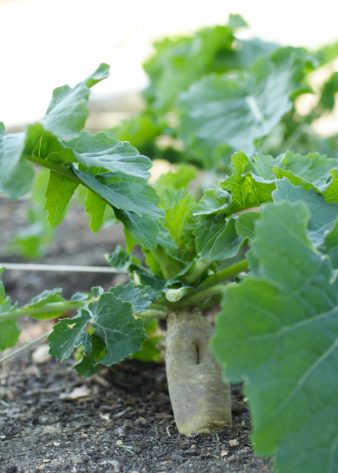Overwintered Mustard Greens
Overwintered mustard greens. Lovely sounding, isn’t it? I love what those three words evoke: a food with a stand-up-and-take-notice personality and a patina of flavor possible only after enduring hardship—the freezing depths of winter.
Right about now, you might find OMGs featured on the menu of some season-driven, farm-to-table restaurant in some food-lively town, along with other locally grown or foraged foods described with equally telling adjectives that marshal a world of artisanal food production: hand-pressed, pickled, preserved, house-cured, tree-ripened, aged, fermented, cellared.
But that’s not where I spotted my over-wintered mustard greens. I found them in my community garden plot early last month, after a premature burst of overly warm weather spun me into a frenzied gardening mode.
After a spate of seventy-degree days, off my husband and I went to our plot to prepare it for spring planting. That was when I discovered the mustard greens that I’d left in the ground last fall as an experiment had made through the winter admirably well. That was in mid-March.
Since then we’ve had two hard frosts, which had me scurrying back to the garden to throw plastic over the small seedlings that had begun to emerge, like tadpoles, around the year-old mustard greens.
“So now you give me a nice warm blanket,” the mustard greens said. “Where were you this January when it was fricking 17 degrees?” I ignored this comment.
Naturally, the stories-high leafy mustard greens, with their knobby trunks and roots that must go very deep, were unfazed by this spring’s fickle behavior.
It’s now mid-April, and I’ve already harvested overwintered mustard greens twice, and will soon harvest another batch. I suggest you get yourself some mustard greens, overwintered or not, and prepare them in a pot with bacon, as follows. The deliciously peppery and pungent flavor of mustard greens is all their own, and is one that is waiting for you to enjoy.
Braised Mustard Greens
This is the same basic method I use to cook all greens, but mustard greens are especially good this way (they are even good cold or at room temperature).
Get yourself some thick bacon, dice it up, and cook it over moderate heat in a large sauté pan until the fat is rendered. Remove the bacon from the pan and leave a good portion of the fat in the pan—you want to have a solid sheen of fat on the bottom. If you enjoy a layered fat flavor experience, pour off more of the bacon fat and make up the difference with one or two or three other fats or oil, such as extra-virgin olive oil, duck fat, lard, ghee, mild-flavored coconut oil (use only a very small amount of the last to avoid a coconut flavor).
Add some finely chopped onion to the pan, season it with salt, and cook it over moderate heat until softened, about 5 minutes. Then add some minced garlic to the pan and cook for another minute or so to soften it as well. Season with black pepper and add some chili pepper, in the amount and form that you prefer, to the pan. (For example, a pinch or two of red pepper flakes; a minced fresh chili pepper, seeded or not; or my recent favorite, a minced fermented chili pepper.)
Begin to add stemmed and chopped mustard greens to the pan, a few handfuls at a time, seasoning each addition of greens with a couple pinches of salt right after you put the greens in the pan. Once salted, use a pair of tongs to toss the greens in the fat until all the greens are shiny and begin to wilt slightly. Repeat with the rest of the greens. When the greens all have been added, salted, and tossed in the fat, add some chicken broth (enough to create steam and keep some liquid in the bottom of the pan, about ½ inch), reduce the heat to medium-low, cover, and simmer until the greens are army green and soft but not mushy. Return the bacon to the pan, toss to combine, and taste for seasoning. Be sure to drink the pot liquor.
Notes: About the recipe: Exact amounts of ingredients depend how much many greens you’re cooking; a ballpark ratio is about 5 slices of bacon, 1 medium onion, 1 or 2 garlic cloves, a couple or three pinches of red pepper flakes or 1 chili pepper, and about a ½ cup of broth for a medium-sized bowl of chopped mustard greens.
About the mustard greens: The variety of mustard greens that I planted in our community garden plot, and that over-wintered well in Richmond, Virginia, is the Southern Giant Curled Mustard. I purchased them Southern Exposure Seed Exchange.


